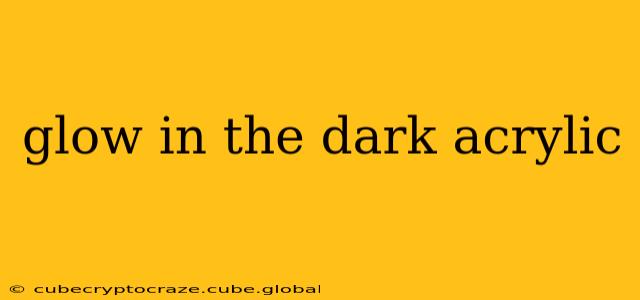Glow-in-the-dark acrylic paints and resins have exploded in popularity, offering a unique and captivating way to add a luminous touch to various creative projects. From vibrant artwork to functional objects, the possibilities are endless. But choosing the right product and understanding how to use it effectively requires some knowledge. This comprehensive guide will explore everything you need to know about glow-in-the-dark acrylics, answering common questions and providing expert tips.
What is Glow-in-the-Dark Acrylic Paint?
Glow-in-the-dark acrylic paints contain phosphorescent pigments that absorb and store light energy. Unlike fluorescent paints, which require a constant light source to glow, phosphorescent paints continue to emit light even after the light source is removed. This "afterglow" effect is what makes them so unique and visually stunning. The intensity and duration of the glow depend on factors such as the pigment concentration, the amount of light absorbed, and the specific type of pigment used.
How Long Does Glow-in-the-Dark Acrylic Last?
The duration of the glow from glow-in-the-dark acrylic paint varies significantly depending on several factors. Firstly, the quality of the pigment plays a crucial role. Higher-quality pigments generally offer a longer and brighter glow. Secondly, the amount of charging light received significantly impacts the glow duration. Exposure to brighter light for a longer period will result in a more intense and longer-lasting glow. Finally, the surrounding environment also affects the glow. Factors such as temperature and humidity can influence how long the pigment continues to emit light. Generally, expect a glow to last from a few minutes to several hours, with the brightest glow typically lasting the shortest amount of time.
How to Make Glow-in-the-Dark Acrylic Paint Glow Brighter?
To maximize the brightness and duration of your glow-in-the-dark acrylic paint, follow these tips:
- Charge it properly: Expose your painted surface to a bright light source, such as direct sunlight or a strong UV lamp, for at least 30 minutes. The longer you charge it, the brighter and longer it will glow.
- Use a high-quality pigment: Invest in glow-in-the-dark acrylic paint from reputable brands known for their vibrant and long-lasting glow.
- Apply multiple coats: Multiple thin coats of paint will generally provide a brighter glow than one thick coat. Allow each coat to dry completely before applying the next.
- Use a dark background: A dark background will make the glow appear more intense.
What is the Difference Between Fluorescent and Phosphorescent Acrylic Paint?
This is a crucial distinction. Fluorescent paints absorb UV light and immediately re-emit it as visible light. They only glow while exposed to a UV light source (like a blacklight). Phosphorescent paints, on the other hand, absorb energy (from any light source) and slowly release it as visible light after the light source is removed. This is the "glow-in-the-dark" effect we associate with these paints.
Can You Mix Glow-in-the-Dark Acrylic with Regular Acrylic Paint?
Yes, you can mix glow-in-the-dark acrylic paint with regular acrylic paints. However, keep in mind that mixing it with other colors will dilute the phosphorescent pigment, resulting in a less intense glow. The more regular paint you add, the dimmer the glow will become. Experimentation is key to finding the right balance between color and luminescence.
What are Some Creative Uses for Glow-in-the-Dark Acrylics?
The applications for glow-in-the-dark acrylics are remarkably diverse:
- Artwork: Create captivating paintings, sculptures, and other art pieces with a unique luminous quality.
- Decorative projects: Decorate vases, furniture, or other household items with a glowing accent.
- Model making: Add a captivating glow to model cars, airplanes, or other miniatures.
- DIY projects: Enhance the visual appeal of DIY projects like jewelry, phone cases, or keychains.
Is Glow-in-the-Dark Acrylic Paint Safe?
Most glow-in-the-dark acrylic paints are non-toxic and safe for use in most applications. However, always check the manufacturer's safety data sheet (SDS) for specific information on the composition and safety precautions for the particular paint you are using. Proper ventilation is always recommended when working with paints.
By understanding the properties of glow-in-the-dark acrylics and following these tips, you can unlock their full potential and create truly mesmerizing and unique projects. Remember to always prioritize safety and explore the endless creative possibilities this medium offers.
